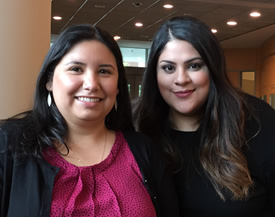When students signed up for Professor Won Kidane's Immigration Law Clinic this spring, they had no idea that their line of work would be the subject of daily headlines and massive protests at airports across the country.
While they worked to help immigrant clients, the rest of the country reacted — strongly — to executive orders from the White House that limited the nation's refugee assistance program and banned entry into the United States by people from certain countries.

"We felt like we were in the thick of it," said third-year student Rebecca Moua. "When we would go to the detention center to meet with clients, there were often protests outside."
Her clinic partner Amrita Singh, also a third-year, said the protesters encouraged them. "They would say, 'Don't let them get you down! You guys are doing great work!' It made me feel a lot more determined."
As the semester came to a close, clinic students won asylum for one client and canceled deportation for another.
Moua and Singh's client was an Afghan man who had been persecuted by the Taliban in his home country; he's now protected by a grant of asylum. Students Dylana Jones and Catherine Carrico represented a young man from Mexico who was brought to the United States as a baby and was threatened with deportation after an arrest on criminal charges. They successfully stopped his deportation.
"It hit me the few weeks before the hearing that this wasn't a mock experience, it was someone's life," said Catherine Carrico. "We were preparing the briefs, we were preparing the witnesses. What we were doing could have an extremely negative or positive impact on his life."
Clients are referred to the Immigration Law Clinic by the Northwest Immigrant Rights Project. Clients are placed in detention until their case can be heard. Many never have the benefit of legal representation. Those who are represented by counsel are six to 10 times more likely to prevail in their claims.
A grant of asylum requires that a client prove three things: a threat of persecution in their home country, membership in a protected class (race, religion, nationality, political opinion, or social group), and failure by their home country's government to stop the persecution.
Singh said their client was a credible and well-spoken witness, which helped his case. "It was certain that if he had been deported back to Afghanistan he would have been persecuted once again, maybe even worse," she said. "It was really a life or death situation. He often reminded us of that. He'd say, 'This is my life.'"

For cancellation of removal (deportation), a client has to show residence in the United States continuously for at least 10 years, good moral character, no felony convictions, and extreme hardship for their U.S. family members if they were to be deported.
Jones said they weren't sure their client would meet the last requirement, but in the end, their brief — 89 pages of legal arguments and testimonials from friends and family — convinced the judge.
"It was the greatest feeling to be able to get this guy back to his children," Jones said. "He's a good guy and this is his home country. He doesn't know anything else. I don't think there's anything better than that feeling."
Moua said the clinic solidified her interest in immigration law as a career.
"Being in a clinic gives you the whole world view approach — ethical considerations, client relationship, building that rapport, legal arguments, plus preparing for trial, and the things we just had to do on the fly with real-world pressure," she said. "The whole experience was an affirmation to me that I should be doing this."
